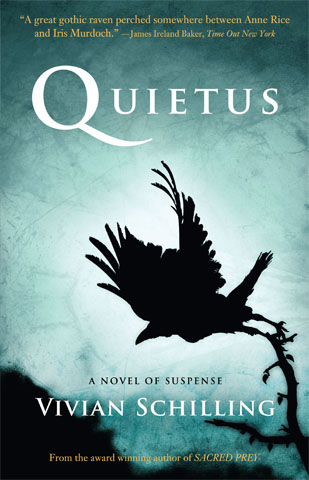
The following questions are intended to enrich and augment your reading group’s discussion of Vivian Schilling’s QUIETUS. For those who have yet to read QUIETUS, please note that in order to provide meaningful and relevant topics for discussion, this material reveals key elements of the plot including some aspects of the novel’s ending.
- Why did the author give death a face, a past and a future? Julius Vanderpoel is the novel’s primary embodiment of death. How does his evolving physicality reflect Kylie’s journey? What does his eventual fate say about life and death?
- While in the mountaintop cabin, Kylie reflects how a place lives and breathes with its inhabitants (Part 1, Ch 14). What role does place play throughout the novel? When Kylie returns to Savannah, the decrepit remains of her childhood home become the personification of her grief. What other times does place become the personification of grief?
- Why did the author choose Kylie O’Rourke as her main character? What traits does Kylie have that facilitate the story?
- How does Kylie’s childhood love for Julius affect her ideas and beliefs as an adult? Are the unresolved issues of this childhood love resolved in the end? Throughout her life, Kylie is drawn to misfits, to non-conformists. How is her past reflected in her relationship with her father? Amelia? Jack? Dillon? Arlin Boyce?
- The author weaves the imagery of art throughout the novel. In what way does art bring the story to life? Does the author effectively use art to present her views? The novel uses dreams as a stepping-stone between the physical and the spiritual. Does the usage of art also allow for a bridging of the two?
- Deprived of all memories in death, Julius is brought back to life through Kylie’s recollections. Kylie in turn finds her own suppressed past through Julius. What ideas does the author explore in her usage of memory? What do you think she is trying to say about the human psyche?
- Kylie’s relationship with her mother, Lila, and her brother, Tucker, continue in spite of their deaths. How does Kylie’s relationship with them grow or change throughout the novel? Had her mother been alive, how would Kylie’s outlook have been different? Why do you think the author chose to make Kylie both motherless and childless?
- “Whether risen from mere thought or from solid matter, the darkness had finally shown itself and it beheld the cold cruel features of” (Part 3, Ch 41) Could it be argued that Julius Vanderpoel, the old man in the subway, and the dark creatures from Kylie’s near-death experience were merely figments of her imagination? Would the physical events of the novel, including all of the deaths, still stand on their own? If so, did the author effectively present a spiritual world that could theoretically co-exist alongside the physical?
- The author creates a mythology about the afterlife by drawing upon past cultures and religious beliefs. How does her mythology differ from others? She makes use of the Reformation and the artwork of that period, drawing correlations and conclusions. In the scene between Eva Ratchford, Arlin Boyce, Kylie and Amelia, (Part 4, Ch 18) were you able to discern what part of their discussion was historical fact and which part fiction? Did the use of actual events give credence to the author’s ideas?
- Amelia is torn by her past and by her decision to abort a child. Does the novel lean in one direction or the other concerning the topic of abortion? Did you feel both sides of the issue were equally presented? In the struggle within herself, what does Amelia ultimately find? After Amelia’s death, Father Matt remains within the ambulance staring down at her ravaged body. (Part 5, Ch 35) What visuals does the author utilize to punctuate this moment and why? What ideas and themes arise out of Amelia’s death?
- By giving Kylie a past with the very specter that has come to take her, the author concludes that both life and death are intertwined and connected. Did she carry this theme throughout and was it consistent? The novel references the following quote twice: “There is not any present moment that is unconnected with some future one. The transition from cause to effect, from event to event, is often carried on by secret steps, which our foresight cannot divine and our sagacity is unable to trace.” (Joseph Addison 1723) Does Quietus reflect life’s complexity and seeming fate? In what way does this relate to the film “It’s a Wonderful Life,” and why did Julius make reference to it in the scene where he visits Kylie in jail under the guise of Ducker? (Part 3, Ch 48) In what way does “Ducker’s” appearance to Kylie mirror the appearance of the angel Clarence to George Bailey in “It’s a Wonderful Life”?
- What is Dillon O’Rourke’s role in the novel? Why does the novel end with his point of view instead of Sean McCallum’s? What issues and obstacles does his character encounter? Dillon seeks to control death and has made this his life’s mission. How does that relate to Hector Haynes and his research of other near-death experiences?
- What aspects of mortality does arsonist Clyde Tremblay seek to escape? Did you have pity, disdain or indifference toward him? Which reaction to his character would Tremblay find most disturbing?
- The author chose to focus on the point of view of numerous characters. Why was Julius Vanderpoel’s point-of-view never taken? The last that the reader sees of Julius is through Kylie’s flashback of a newscast. (Part 6, Ch 59). Why do you think the author chose to resolve Julius’s character in this manner? Was the shift in Kylie’s own thoughts and character a factor?
- Does Quietus capture the many facets of death? Does it capture the unpredictability, the ruthlessness, the beauty of death? Has it mirrored or given insight into your own experiences?

